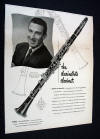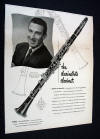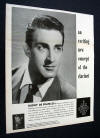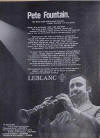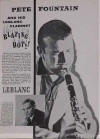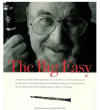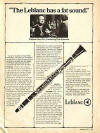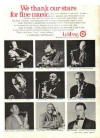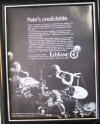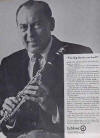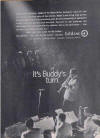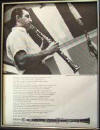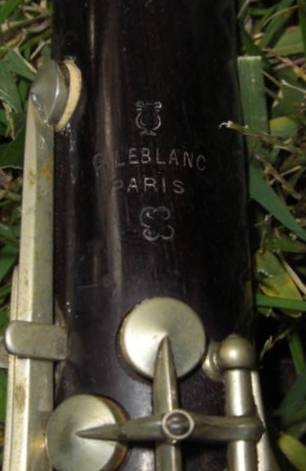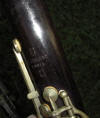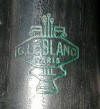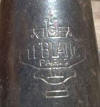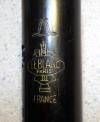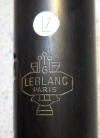2010 from the International Directory of Company Histories
Statistics:
Private Company
Incorporated: 1946 as Leblanc USA
Employees: 500
Sales: $65 million (2001 est.)
NAIC: 339992 Musical Instrument Manufacturing
Company Perspectives:
No other manufacturer can offer as wide a selection of brass and woodwind
instruments crafted with the same integrity and dedication to excellence as does
Leblanc. Through all stages of the company’s growth, advancement and
acquisitions, it has never lost sight of the principles on which it was founded.
Long ago, Georges Leblanc established the basic tenets of integrity,
musicianship and creativity for his firms to live by. At G. Leblanc Corporation,
these principles still live on, propelling the company into the 21st century.
Key Dates:
1750: Noblet is established in France.
1904: Noblet passes the business to the Leblanc family.
1921: Leblanc begins distribution of clarinets in the United States.
1946: Pascucci founds Leblanc USA in Kenosha.
1964: The company acquires the Frank Holton Company.
1971: The company acquires the Martin Band Instrument Company.
1989: A 65 percent interest in the French parent is acquired.
1993: A U.S. firm completes the acquisition of Leblanc S.A.
2000: Leon Leblanc dies; the U.S. plants are expanded and upgraded.
Company History:
The G. Leblanc Corporation is one of the world’s leading makers of woodwind and
brass instruments. The company manufactures instruments under the brand names
Leblanc, Noblet, Normandy, Vito, Holton, Martin, and Courtois. Leblanc’s Holton
subsidiary is the world’s largest maker of French horns, and makes other brass
instruments as well. Leblanc’s Martin subsidiary is known for an esteemed line
of trumpets, and specializes in smaller brasses. Leblanc also manufactures
instrument cases and woodwind mouthpieces. Leblanc operates three factories in
the United States, in Kenosha and Elkhorn, Wisconsin, and one plant in La
Couture-Boussey, France. The company was originally set up as a joint venture
with a French company, Leblanc S.A. Leblanc S.A. was one of the oldest
corporations in France, tracing its roots back to 1750. Leblanc USA purchased a
majority interest in the French company in 1989, then acquired the entire firm
in 1993. Leblanc has been a key promoter of school music programs in the United
States from the 1950s onward. The company manufactured an improved line of
instruments for beginning students and helped establish the type of instrument
rental practice that is now an industry standard. The company helped organize
the school musical instrument sales industry, and its efforts led to the
founding of the National Association of School Music Dealers.
18th-Century French Antecedents
The G. Leblanc Corporation harks back to the reign of Louis XV in France. The
king promoted music at his court, leading to a new French musical instrument
industry. The firm of Ets. D. Noblet was founded in 1750 in La Couture-Boussey
to make woodwind instruments. Noblet was known for its clarinets and helped make
France a European center for woodwind manufacturing. Members of the Noblet
family operated the company until 1904. In that year, the last Noblet died
without an heir, so the firm passed to Georges Leblanc. Leblanc was also a
member of an illustrious family of woodwind makers, thought to be the best at
his craft in all France. His firm, G. Leblanc Cie., was centered in Paris.
Leblanc continued to manufacture the Noblet line of clarinets at La Couture-Boussey,
while making improvements to Leblanc instruments in his Paris workshop. The
business was a family affair. While Georges fought in World War I, his wife
Clemence managed the factory. Later his son Leon greatly expanded and improved
the business. The Leblanc family also worked with Charles Houvenaghel, a famed
acoustic scientist. Houvenaghel and Leblanc set up an acoustical research
laboratory, the first of its kind, and applied their research to instrument
manufacture. Leblanc and Houvenaghel designed new clarinets in unusual ranges.
They eventually made a line of clarinets ranging from the piccolo-like sopranino
to the extremely low octo-contrabass–a whole clarinet choir, with a greater
pitch spread than a string orchestra.
Leon Leblanc took his company’s scientific principles even farther. Leon was
a gifted clarinetist who took the top prize at the Paris Conservetoire as a
young man. Although he could have had a great career as a performer, Leon chose
to stay with the family business and apply his musical insight to instrument
manufacture. He dedicated his life to bringing acoustical, mechanical, and
musical improvements to woodwind instruments. Although Leblanc’s instruments
were almost entirely handmade, Leon Leblanc insisted that the craftsmen follow
careful measurements. “Music is an art, but it is still governed by the laws of
science,” he declared (Music Trades, July 1996). As a result, Leblanc
instruments were more consistent than those that had come before. The company
continued to strive for consistent quality, ease of playability, and mechanical
innovation, throughout its history.
Postwar Beginnings of the American Firm
G. Leblanc Cie. had worked with an American distributor since 1921. It gave
exclusive rights to U.S. distribution to Walter Gretsch, who ran the large
musical instrument company Gretsch & Brenner. Although the Leblanc family had
strong personal ties to Walter Gretsch, the arrangement had many problems. The
Leblanc instruments came from France by sea, and arrived in New York in terrible
shape, out of tune and sticky from two weeks of exposure to damp and cold.
Gretsch sold the instruments in this condition, much to the distress of the
French manufacturer. But because Gretsch handled many product lines, he did not
devote particular care to the Leblanc clarinets, and he did not have the time to
acclimate and recondition the imports. Thus, the Leblancs were already thinking
of an alternative to this distributorship when they met a young U.S. soldier in
1945. This was Vito Pascucci.
Pascucci grew up in Kenosha, Wisconsin, the son of Italian immigrants of
modest means. His family had a musical bent, and Vito began playing the trumpet
as a young boy. By the time he was 12, he was traveling to Chicago on weekends
for lessons. After his lesson, he used to stop in at the Chicago Musical
Instrument Company and watch the repairmen. When he was a teenager, he began
repairing instruments in the back of a music store run by his older brother,
Ben. In 1943, Pascucci was drafted into the army. He applied to join the army
band, and was given a spot as the band repairman. Pascucci’s band included three
former members of the Cleveland Symphony, and with this kind of competition, he
could not make it as a trumpet player. But later the famed swing band leader
Glenn Miller began putting together his own army band. He snagged the symphony
players, and they recommended he take Vito Pascucci as well. When Pascucci got a
letter ordering him to report to the Glenn Miller band, he thought it was a
hoax. Pascucci spent days trying to get the letter authenticated. He had no idea
how Miller would have heard of him. When they finally met, Pascucci recalled
that Miller treated him like a nonentity. But Pascucci had a chance to show his
skills when a bandmate came to him with a smashed trumpet that he needed to be
able to play the next morning. Pascucci worked all night and repaired the
damaged trumpet with only a broomstick. Miller was impressed, and they began
having lunch together every day. They became good friends, and came up with a
plan to launch a chain of Glenn Miller Music Stores when the war was over. They
planned to import European instruments, which were of better quality than
U.S.-made ones.
Glenn Miller’s plane disappeared over the English Channel on December 15,
1944. Pascucci was crushed at the loss of his friend. Nevertheless, he went on
with plans he and Miller had made, and arranged to visit musical instrument
factories in France. He wanted to meet the maker of Noblet clarinets, because he
had seen those instruments at the Chicago Musical Instruments store he used to
haunt as a child. Someone directed him to the Leblanc factory in La Couture-Boussey,
where he met Georges and Leon Leblanc. The family had suffered during the German
occupation. The Leblancs had had to trade clarinets for food in order to
survive. The factory was down to only 20 workers, and raw materials were
virtually non-existent. But the family instantly took to the young American
repairman, showing him the workshop and teaching him some new skills. When he
told the Leblancs about the Glenn Miller Music Stores idea, they instead asked
him to distribute their instruments in the United States. Pascucci was taken
aback. He felt that he did not know enough about business to take on such a
responsibility. But the Leblancs liked him and trusted him. He left the factory
with a duffel bag full of clarinets, and Leon Leblanc promised to meet him in
the United States when the war was over.
Leblanc kept his promise and wired Pascucci to come to New York in 1946. The
first order of business was to sever the firm’s relationship with Gretsch &
Brenner. Walter Gretsch had died, and the Leblanc business contract had passed
to his daughter Gertrude. Gertrude happened to be married to John Jacob Astor,
one of the wealthiest men in the country. Pascucci could not believe Leblanc
would choose him, a poor Wisconsin boy, to run the U.S. distributorship, rather
than the Astors. But all this worked out, and Pascucci entered a 50-50
partnership with G. Leblanc Cie., forming Leblanc USA in May 1946. Although
Leblanc had wanted Pascucci to work in New York, where the musical instruments
import business was centered, Pascucci insisted on returning to his hometown. So
he signed a lease for a tiny storefront in Kenosha. He began by taking in the
Leblanc instruments and making them playable, something Walter Gretsch had never
bothered to do. Demand for musical instruments was on the rise, with the war
over and a return to peacetime activities. With the baby boom that followed the
war, school music programs also grew quickly, and Leblanc USA began supplying
inexpensive instruments for beginners.
Expansion in the 1960s
The school market was the best opportunity for the young company, as the
country’s school-age population swelled. The company began importing
inexpensive, durable instruments that were easy to play. It began in the 1950s
with a line of metal clarinets. But plastic clarinets were already popular, so
the firm abandoned metal and began making plastic student instruments. Demand
was so great that the French factory could not supply enough. So Leblanc USA
began manufacturing its own instruments for the first time, forming the plastic
bodies and fitting them with French-made keys. This new line was given the name
“Vito.” Eventually the entire “Vito” clarinet line was made in Kenosha,
including the keys. The small factory expanded in 1953, and then again several
times in the 1960s.
Leblanc worked to tame the school music industry, which had been a highly
fractured market. In 1950 the company hired a music educator, Ernest Moore, to
work on educational programs and materials for music teachers. Leblanc was the
first wind instrument manufacturer to hire a music educator, and it continued to
keep the post filled with distinguished pedagogues up to the present time.
Leblanc also began organizing monthly meetings for musical instrument dealers,
giving them a chance to compare notes and discuss ways to improve the business.
The dealers who met under Leblanc’s auspices adopted a rent-to-own policy,
whereby students rented an instrument for a year and the payments could be put
toward an eventual purchase. This became the standard way the student music
industry worked, and it made sense for both the students and the instrument
dealers. Some of the dealers who had met at the Leblanc meetings later organized
the professional group the National Association of School Music Dealers.
By the late 1950s, Leblanc had become a major player in the school music
industry. But its product line was limited to woodwinds. In 1964 the company
acquired the Frank Holton Company, a maker of brass instruments. Holton was
founded in Chicago in 1898 by a former trombonist with the John Philip Sousa
band. In 1917 Holton moved to Elkhorn, Wisconsin. Leblanc bought the company,
gaining its dominant Collegiate brand of student brass instruments. Under
Leblanc’s management, the Holton company began improving its French horn
manufacturing. The firm developed a prized line of French horns, valued by
professional players around the world. Holton eventually became the world’s
largest manufacturer of French horns. It also makes trombones, euphoniums, and
other large horns.
Leblanc diversified further in 1968, when it bought The Woodwind Company.
This was a small company that specialized in making woodwind mouthpieces. Around
the same time it also bought an instrument case manufacturer, the Bublitz Case
Company. Bublitz was based in Elkhart, Indiana. In 1971 Leblanc bought another
Elkhart company, the Martin Band Instrument Company. Martin was the oldest band
instrument manufacturer in the country, excepting the time it had been closed
down for the Great Chicago Fire. It made a line of brass instruments, including
the Martin Committee trumpet, an instrument still prized by jazz players today.
Leblanc closed down Martin’s Elkhart plant and moved manufacturing to a new
facility in Kenosha. Leblanc also cut the overlap between its two brass
subsidiaries by concentrating the making of trumpets and other small horns at
Martin and letting Holton specialize in the larger instruments.
Leblanc expanded its facilities to make room for the new product lines and
updated the Elkhorn and Kenosha factories. Leblanc constantly improved the
technology it used to build instruments, following Leon Leblanc’s dictum that
science governed music. The firm designed and built much of the machinery it
needed to automate the manufacturing process. Pascucci also insisted that the
factory be a pleasant place to work, despite the prevalence of machines. Workers
looked through glass walls into a garden, and quiet hallways were hung with
paintings. Pascucci himself continued to innovate, developing new manufacturing
methods as well as new models and new instruments. The company prepared for five
years before it began making a new instrument, the descant horn, in the 1970s.
By 1980, Leblanc had become the third largest manufacturer of wind instruments
in the United States.
Buying the French Firm in the 1980s
In 1975 Pascucci’s son Leon (named for Leon Leblanc) joined the company,
beginning as vice-president for advertising. The younger Pascucci contributed to
the striking interior design of the Leblanc headquarters, and became known for
staging beautiful exhibits at industry trade shows. He seemed to have the
artistry and flair that was vital to the firm’s image. In the 1980s, Vito
Pascucci began thinking of buying out the French firm. Leon Leblanc, born in
1900, was an elderly man with no heirs. It seemed natural that Pascucci would
take over. He and his son would continue to run the company along the lines
Leblanc had established. Pascucci began seriously negotiating the sale in 1986.
Leblanc himself was all for giving Pascucci control. But the transaction
involved selling one of the oldest businesses in France to an American, and this
was difficult for the French government to abide. When Pascucci made his first
inquiries, the French Ministry of Trade told him that odds were 100 to one
against his ever buying Leblanc.
Over the next three years Pascucci made more than 20 trips to Paris to meet
with French government officials. Because of the age of its Noblet subsidiary,
Leblanc was considered a national treasure. Pascucci finally won approval to buy
65 percent of Leblanc S.A., as the French company was then known. But the deal
was so sensitive that the French prime minister, Francois Mitterand, had to okay
it. After the purchase, the Leblanc company sent a survey to clarinetists all
over the world, asking their input for future clarinet models. The company then
brought out a new line of improved instruments, which were made at the French
factory in La Couture-Boussey. In 1991, Leon Pascucci became president of G.
Leblanc Corporation. In 1993, the U.S. firm completed its acquisition of Leblanc
S.A., acquiring the remaining 35 percent of the company. The new legal
arrangements made little difference to how the company operated. The French
factory employed about 100 workers, and the U.S. factories about 400. Overall
sales were estimated at $37.5 million.
New Technology in the 2000s
Leon Pascucci was credited with continuing the drive toward automation at the
company. This meant not only in the factory areas but in accounting and sales.
Pascucci also served as president of the National Association of Band Instrument
Manufacturers, an industry group that helped raise money for school music
programs. He also helped the city of Kenosha raise funds for a bandshell on the
Lake Michigan shore, and sustained the community band and orchestra. In 2000,
the company began a multimillion dollar expansion. The main Kenosha plant
doubled in size, and the company brought in scores of new machines. The firm
stopped using toxic materials, such as brass cleaners, in favor of
environmentally sound and efficient processes like sonic buffers. Leon Leblanc
died that year, at the age of 99. The company was still operating on the
principles he had laid out, with mechanical efficiency wedded to artistic
production. In 2001 the G. Leblanc Corporation was given an “Industry World
Leadership” award by the Wisconsin Manufacturers & Commerce association, the
state’s largest business group. The award noted the bold steps the company had
taken in implementing new technology.
In 2003 the company’s French factory was damaged by a suspicious fire. The
ancient La Couture-Boussey plant suffered more than $3 million of damage, but
volunteer fire fighters put out the flames before the building was destroyed.
Although some inventory was lost, the factory’s valuable stock of antique
hardwood was not harmed. The factory was back in production about two months
after the fire.
Principal Subsidiaries: Frank Holton Company; Martin Band Instrument Company;
Woodwind Company; Bublitz Case Company.
Principal Competitors: Conn-Selmer, Inc.; Yamaha Corporation.
——————————————————————————–
Further Reading:
■ Bednarek, David I., “G. Leblanc Strives for Perfect Pitch,” Milwaukee
Journal, June 20, 1993, p. B1.
■ Dunn, Michael J., III, “The Musical World of G. Leblanc,” Wisconsin Trails,
Summer 1980, p. 35.
■ “Improving Productivity and Quality, Pursuing the Perfect Clarinet,” Music
Trades, July 2000, p. 162.
■ “Leblanc Turns 50,” Music Trades, July 1996, p. 134.
■ “Leblanc U.S. Buys Leblanc Paris,” Music Trades, June 1989, p. 34.
■ “Leon Pascucci Named Leblanc CEO,” Music Trades, December 2001, p. 145.
■”U.S./French Collaboration at Leblanc Yields New Pro Clarinets,” Music Trades,
January 1991, p. 53.
Source: International Directory of Company Histories, Vol. 55. St. James
Press, 2003.
